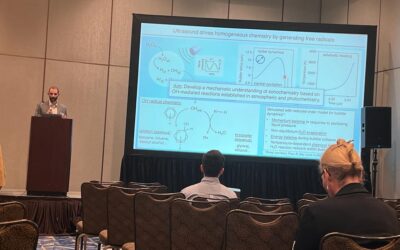BUBBLE
CREATE Seed Collaboration: Orchestrating Chemistry in a Bubble to Upcycle Food Waste into Specialty Chemicals
PIs and partners
Collaboration team members
- Lead PI (1) – Prince N. AMANIAMPONG, CNRS Researcher, Poitiers University;
- Lead PI (2) – Tej S. CHOKSI, Nanyang Technological University, Singapore;
- Co-I (1) – Wen (Paul) LIU, Nanyang Technological University, Singapore;
- Co-I (2) – Sabine VALANGE, University of Poitiers, France;
- Collaborator – James KWAN, University of Oxford, Department of Engineering Science
- Post Doc: Ari FISCHER, Nanyang Technological University, Singapore
- Post Doc: Roberto BATISTA, CNRS@CREATE
The project started on 01 October 2021 and ended on 31 March 2023.

Lead PI (1) – Prince N. AMANIAMPONG, CNRS Researcher, Poitiers University;

Lead PI (2) – Tej S. CHOKSI, Nanyang Technological University, Singapore;
Abstract
Singapore’s economy will significantly restructure as the Republic transitions into a carbon neutral economy. This restructuring will entail a reduction in energy consumption, and increased levels of waste recycling. The magnitude of food waste which will need to be recycled will significantly increase in the next decade. This is because by 2030, Singapore aims to develop local capabilities to meet 30% of the food requirements. Hence food waste will naturally emerge as a potential raw material for chemical manufacturing in a circular economy. For instance, cellulose obtained from food waste can be first depolymerised to glucose; followed by upcycling glucose into high value specialty chemicals. To minimise energy consumption, such waste to value processes require high selectivity to desired products and should operate under ambient conditions. We recently showed that cellulose can be valorised into high value specialty chemicals by leveraging the synergy between catalysts and ultrasound irradiation. In the proposed work, we aim to understand at a fundamental level, how ultrasound mediated processes convert cellulose into specialty chemicals at room temperature with minimal energy inputs. Successes in this proof of concept can then be extended to other waste to value supply chains that lie at the nexus of Singapore’s chemical manufacturing and waste recycling sectors.

Ultrasound assisted upcycling of cellulose to specialty chemicals.
News
[BUBBLE] CNRS Bronze Medal 2024 awarded to Prince Amaniampong
Bubble at the American Institute of Chemical Engineers (AIChE) Annual Meeting
[BUBBLE] Young Researcher Prize awarded to Prince Amaniampong
BUBBLE Seed Project: Research Fellow
CREATE Seed project: Orchestrating Chemistry in a Bubble to Upcycle Food Waste into Specialty Chemicals

Prince Amaniampong visited Singapore from 2 to 15 April 2022 to attend meetings and work sessions for Bubble collaboration. He also visited the CNRS@CREATE office.
Delighted to host @PrinceaNana at @NTUsg as part of our ongoing intra CREATE grant @CNRSatCREATE @CREATE_NRF on using ultrasound to upcycle waste with @wenliu2425 @KwanResearch. Amazing seminar, great discussions, and a homecoming for Prince! Looking forward to your next visit! pic.twitter.com/JLsuV9KzEt
— Tej S. Choksi (@tejchoksi) April 15, 2022
This research is supported by the National Research Foundation, Prime Minister’s Office, Singapore under its Campus for Research Excellence and Technological Enterprise (CREATE) programme.
CREATE is an international collaboratory housing research centres set up by top universities. At CREATE, researchers from diverse disciplines and backgrounds work closely together to perform cutting-edge research in strategic areas of interest, for translation into practical applications leading to positive economic and societal outcomes for Singapore. The interdisciplinary research centres at CREATE focus on four areas of interdisciplinary thematic areas of research, namely human systems, energy systems, environmental systems and urban systems. More information on the CREATE programme can be obtained from www.create.edu.sg.
Visit the CNRS website here.
![[BUBBLE] CNRS Bronze Medal 2024 awarded to Prince Amaniampong](https://www.cnrsatcreate.cnrs.fr/wp-content/uploads/2024/02/BRONZE-2024_AMANIAMPONG-Prince-Nana-©-Yves-Almecija.png-400x250.png)

![[BUBBLE] Young Researcher Prize awarded to Prince Amaniampong](https://www.cnrsatcreate.cnrs.fr/wp-content/uploads/2022/04/Bubble-2022-Prince-A-400x250.png)

